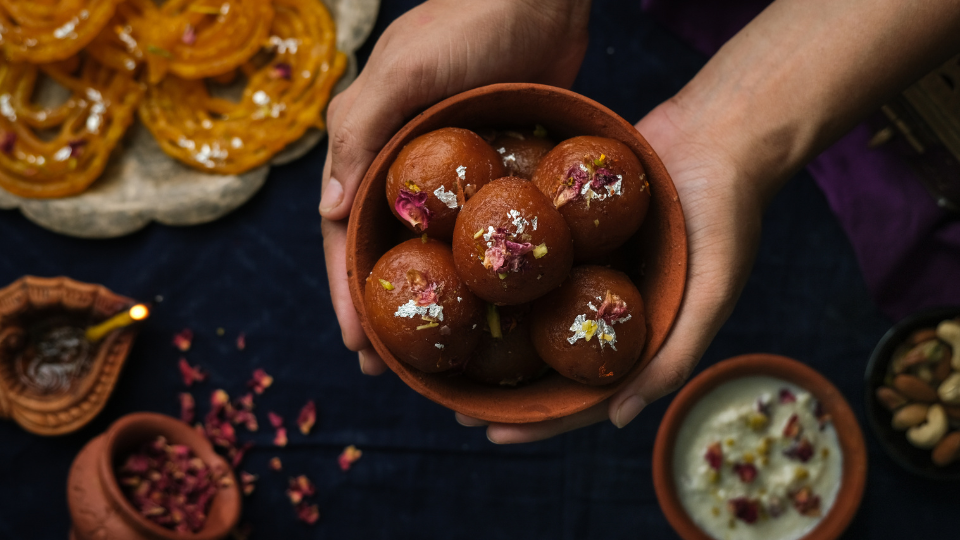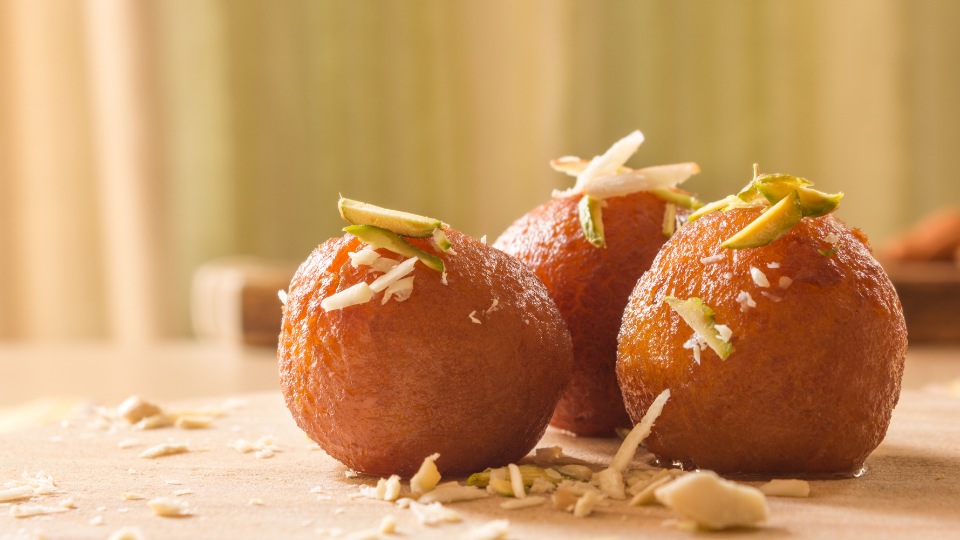Introduction
Few desserts hold the same emotional and cultural significance as gulab jamun. This golden-brown delicacy, soaked in fragrant sugar syrup, is not just a sweet—it’s a symbol of celebration, togetherness, and heritage. Across generations, families have cherished gulab jamun during weddings, festivals, and casual gatherings, making it an integral part of culinary traditions. Whether enjoyed warm or cold, its rich flavors instantly connect people to nostalgia, culture, and community, reminding us of the sweetness of shared moments.
In this blog, we’ll explore the rich history and cultural heritage of gulab jamun. From its origins in the Mughal courts to its presence in modern fusion desserts, gulab jamun’s journey is as fascinating as its taste. We’ll also look at its regional variations, symbolic role in festivals, and how it has become a global favorite. If you want to experience authentic gulab jamun and other Indian sweets, you can explore the Maharaja Riyasat menu and indulge in true culinary royalty.
Things to Know About Gulab Jamun’s Origins
Before diving into gulab jamun’s global influence, it’s important to understand its roots. Its history spans across centuries, shaped by diverse cultures and evolving tastes. Let’s uncover the essential aspects of its origin and transformation.
Persian and Mughal Influence
The origins of gulab jamun trace back to Persia, where similar fried dough confections were first made. When the Mughals brought their culinary traditions to India, they infused Persian techniques with Indian flavors. The word “gulab” itself is derived from the Persian “gol” (flower) and “ab” (water), a reference to rose water syrup that traditionally flavored the dessert. Over time, Indian chefs adapted these recipes, giving rise to the soft, syrupy gulab jamun we know today.
The Mughal courts popularized the dish, where it was considered a royal indulgence. Rich ingredients like khoya, saffron, and cardamom elevated its flavor. This fusion of Persian and Indian culinary art led to the dessert’s prestige, cementing gulab jamun as an essential sweet at grand feasts. Even today, many Indian sweets carry this Mughal legacy, much like biryani and kebabs that also emerged from the same cultural exchange.
The Etymology of Gulab Jamun
The name “gulab jamun” itself is a story. As mentioned, “gulab” means rose water, while “jamun” refers to a small, dark-purple fruit native to India. The resemblance of the sweet’s round shape and deep color to the jamun fruit gave it the second half of its name. Together, the name beautifully symbolizes the blend of Persian influence with Indian identity.
Etymology aside, the dessert’s cultural value lies in how its name has become universal. Across South Asia and the Indian diaspora worldwide, gulab jamun retains its name and recognition. It serves as both a cultural marker and a testament to the dish’s timeless appeal, much like how paneer butter masala represents the essence of Indian curries.
Regional Variations Across India
India’s culinary diversity has given rise to countless variations of gulab jamun. In North India, khoya-based gulab jamuns are the most popular. In Bengal, a similar sweet called “pantua” is made, while in South India, milk powder or flour-based versions are common. Each region has added its own flair—sometimes soaking the balls in jaggery syrup instead of sugar, or stuffing them with nuts for added richness.
These variations highlight the adaptability of the dessert. Just as roti and paratha vary across India’s regions (learn more about paratha vs roti), gulab jamun has embraced local tastes while retaining its core identity. This flexibility has ensured its survival and popularity through centuries of changing food trends.
Symbolism in Festivals and Weddings
Gulab jamun is more than just food—it’s symbolic. In Indian weddings, it represents sweetness for the new journey ahead. During Diwali, Eid, and Holi, gulab jamun is a staple, symbolizing prosperity, happiness, and unity. The dessert is not only enjoyed but also gifted, strengthening social bonds.
This symbolic role extends beyond religious boundaries. Gulab jamun’s universal appeal has made it a cultural bridge, much like Punjabi food traditions that unite people across communities. Offering gulab jamun is seen as a gesture of love and goodwill, reinforcing its place in cultural celebrations.
Global Popularity and Modern Fusion Desserts
Today, gulab jamun has transcended borders. From Indian restaurants in Canada to global fusion kitchens, it has taken many new forms—gulab jamun cheesecakes, ice creams, and even cocktails. Its versatility has kept it relevant, appealing to younger generations while honoring tradition.
The global journey of gulab jamun mirrors that of Indian cuisine itself. Just as dishes like chicken tikka masala have found international fame, gulab jamun represents the sweetness of Indian culture worldwide. Its adaptations show that tradition and innovation can coexist beautifully.
Gulab Jamun in Mughal Courts
The Mughal courts were the birthplace of gulab jamun’s prestige. Lavish feasts often featured this sweet as a centerpiece. Cooked in pure ghee and infused with saffron, these early gulab jamuns were a symbol of opulence. They reflected the Mughal emphasis on refined culinary experiences, blending Persian elegance with Indian richness.
The Mughal legacy continues to influence Indian desserts today. Their tradition of grandeur and indulgence still inspires chefs at fine-dining establishments. At Maharaja Riyasat, this same ethos of royal dining is celebrated, giving diners a taste of heritage through authentic recipes.
Gulab Jamun in Indian Festivals
From Diwali to Eid, gulab jamun is a festival favorite. Its sweetness is seen as an omen of joy, while its round shape symbolizes wholeness and unity. Families prepare or purchase gulab jamuns in bulk to share with loved ones during festivities, reinforcing its role in collective celebration.
During Diwali, gulab jamun’s presence is nearly unavoidable, much like the sound of firecrackers or the glow of diyas. Its role in Eid feasts also emphasizes harmony and togetherness, bridging traditions across religions. In this way, gulab jamun becomes not just a dessert but a cultural connector.
Gulab Jamun and Family Traditions
Every Indian household has a gulab jamun story. Some families treasure recipes passed down for generations, while others associate it with memories of festive gatherings. Children often learn to roll and fry gulab jamun balls alongside their parents, making it part of their culinary education.
These traditions extend into the diaspora. For Indian families abroad, making gulab jamun keeps them connected to their roots. It’s not just about taste, but about preserving identity and passing down heritage through food, much like how biryani binds generations together.
Gulab Jamun in Modern Indian Cuisine
Modern Indian chefs have reimagined gulab jamun with creativity. Variations like chocolate-stuffed gulab jamun, baked versions, and fusion desserts have entered contemporary menus. Restaurants now experiment with plating styles and pairings, elevating gulab jamun into fine dining experiences.
Yet, even with these innovations, the heart of gulab jamun remains unchanged—soft, syrupy, and comforting. This blend of tradition and modernity ensures that gulab jamun appeals to both purists and adventurous eaters, continuing its relevance in evolving culinary landscapes.
Gulab Jamun Beyond Borders
Beyond India, gulab jamun is a global star. It is widely available in Indian restaurants across North America, Europe, and the Middle East. Its popularity has grown not only among the diaspora but also among locals who’ve embraced it as part of their sweet repertoire.
In Canada, gulab jamun has become a staple of Indian dining. Restaurants like Maharaja Riyasat bring authentic recipes to international audiences, allowing food lovers to experience the rich cultural heritage of Indian desserts firsthand. It has become a cultural ambassador, much like Punjabi dining in Vaughan.
Why Choose Maharaja Riyasat for Authentic Gulab Jamun?
Maharaja Riyasat is more than a restaurant—it’s a celebration of Indian culinary royalty. Their gulab jamun is made using authentic methods, with khoya, saffron, and cardamom creating the perfect balance of richness and aroma. Each bite reflects centuries of tradition and the legacy of Mughal kitchens.
Beyond gulab jamun, Maharaja Riyasat offers a wide variety of Indian sweets and dishes, each crafted to preserve authenticity. With locations like Mississauga, and a full-service reservation system, dining here is not just about food but about experiencing heritage. Choosing Maharaja Riyasat means choosing a royal experience in every bite.
Conclusion
The history and heritage of gulab jamun reveal why it remains one of the most beloved Indian desserts. From its Persian roots and Mughal refinement to its regional adaptations and global popularity, gulab jamun embodies the story of Indian culinary evolution. It is both a dessert and a cultural emblem, symbolizing joy, unity, and tradition across generations.
Whether you’re celebrating a festival, honoring family traditions, or exploring modern Indian cuisine, gulab jamun always holds a special place. To experience authentic flavors, visit Maharaja Riyasat and indulge in this royal delicacy. With every bite, you’ll taste not just sweetness, but centuries of history and cultural richness.
Summary
Gulab jamun is more than a dessert—it’s a heritage. From Persian origins to Mughal refinement, regional adaptations, and global fusion, its journey is a testament to cultural exchange and culinary artistry. It is celebrated at weddings, festivals, and family gatherings, bridging communities and generations. Maharaja Riyasat continues this tradition, offering authentic gulab jamun alongside a royal dining experience. For anyone craving the sweetness of history, culture, and flavor, Maharaja Riyasat is the perfect destination to indulge in authentic Indian cuisine.

